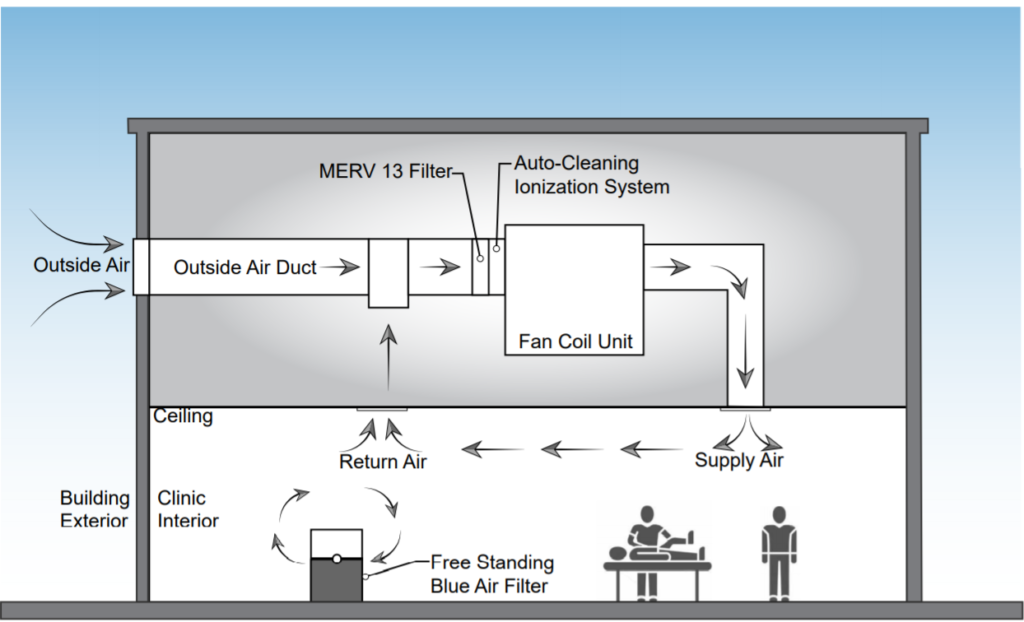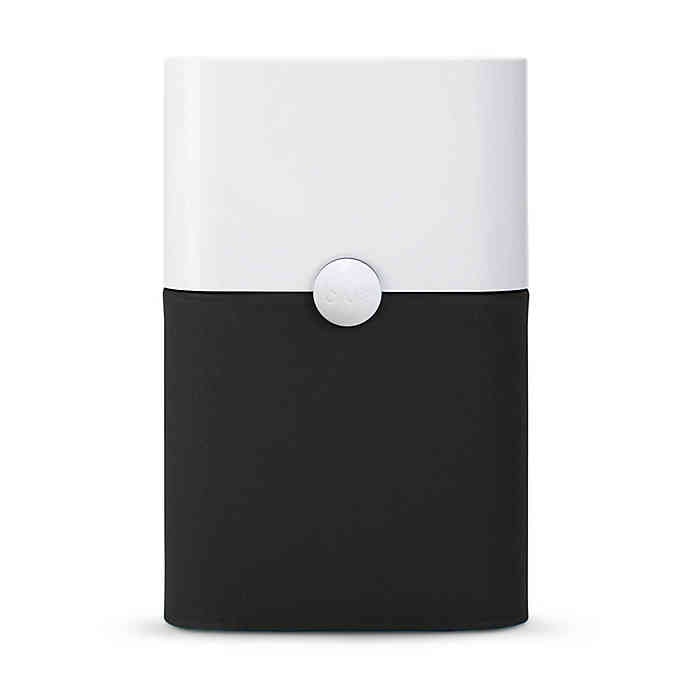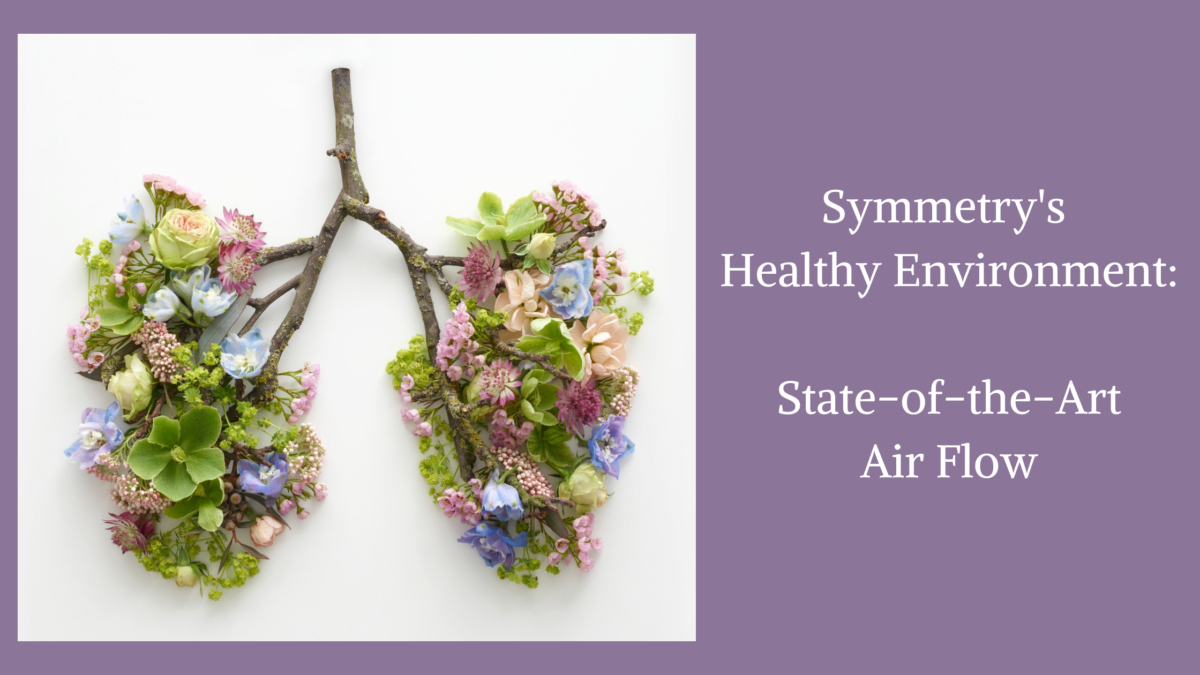Symmetry’s new clinic space at the Park Bend Medical Plaza includes multiple amenities. One of our favorite features is the broad green-space view out of our multiple huge windows! Visual connection to the natural outdoor landscape and to the daily patterns of sunlight feels healthful. In fact, it is known that exposure to sunlight helps with regulation of sleep and mood. (For more on the health benefits of sunlight, check out this WebMD slide show.) Research also demonstrates that exposure to nature can decrease stress and physical factors such as blood pressure and muscle tension. (This article published by the University of Minnesota explains further.)
On a more mechanical note, the construction process for Symmetry’s new building allowed us the opportunity to make some upgrades that also enhance environmental health. A significant highlight is our mechanical Heating, Ventilation, & Air Conditioning (HVAC) system. Air flow within a building is not something that the average citizen thought about much before this current pandemic era. However, it is likely that we are now much more familiar with the concept of “ventilation” and how it can affect health. If the terms “dilution”, “aerosol”, and “droplet transmission” are now part of your typical vocabulary, it’s likely that you’ll be interested in reading further… Be prepared to “geek out” on the science of HVAC. Or if you prefer, simply skim the forthcoming bullet point headings to get a sense of the ways in which we’ve designed Symmetry’s new system to help keep our clinic healthy.
Maintaining a healthy environment – be that in a medical clinic or a science lab or a residential home or apartment – typically involves multiple procedures. For example, washing hands before handling food, cleaning surfaces that are dusty, taking off muddy shoes before walking on the rug, and scrubbing mildew off of bathroom tile are all ways that typically contribute to limiting the spread of germs in the home. The coronavirus pandemic has now also taught us that washing hands, wearing a mask, and avoiding prolonged close contact with other humans are all ways that limit the transmission of illness in the community. Health care facilities have always also taken extra steps to limit the possibility of spreading disease or infection – such as using medical-grade cleaning products and in many cases installing highly technical air flow systems into places like operating rooms or intensive care units. The use of multiple measures simultaneously is called an “infection control bundle”. Put simply, when working to prevent disease, the more layers or protection the better!
Currently, updated and upgraded recommendations for air flow are being developed to improve health and safety in all types of buildings – from schools to restaurants to commercial buildings with multiple uses. The U.S. Environmental Protection Agency (EPA)has stated that “Increasing ventilation, when used along with other best practices, can be part of a plan to protect people indoors.” The Centers for Disease Control and Prevention (CDC), and professional commercial organizations such as the American Society of Heating, Refrigerating, and Air-Conditioning Engineers (ASHRAE)have also published recommendations regarding ventilation and air flow. (If you are interested in a lengthier read about the current ASHRAE recommendations – graded by level of scientific evidence – check out this link. Evidence levels range from A – Strong Evidence, meriting a strong recommendation, to E – Insufficient Evidence, meaning that more information is needed)
The following information is a summary of features of Symmetry’s new HVAC system. Each feature matches current ventilation recommendations (from ASHRAE) that aim to reduce the indoor concentration of airborne contaminants – including viruses, but also bacteria, mold, pollen, smoke, and a variety of other particles.

- Design clean air flow paths to encourage the exit of airborne particulates. (Evidence Level A)
- The diagram above demonstrates the basic principles of Symmetry’s ventilation system. The Symmetry suite has its own dedicated system that is totally separate from the air flow systems in the building hallway or any of the other suites in the building. This means that no air from any other part of the building gets mixed in with the air in Symmetry’s clinic. Our staff and clients are exposed only to indoor air that we manage.
- Symmetry’s suite has 5 different Fan Coil Units within the space. The Fan Coil Units (FCUs) are responsible for moving air to and from a designated space within the clinic. Having 5 different units means that the basic air circulation pattern for each area of the clinic is somewhat separate from that of the other areas. The air that is circulating in the staff break room and staff offices is different than the air that is circulating in the waiting area. The air circulating in the waiting area is different than the air that is circulating in the various areas of the patient treatment and gym areas. And the open area in Symmetry’s gym has 3 different zones – all with relatively independent air flow.
- Enhance filtration with upgraded air system filters. (Evidence Level A)
- Each of Symmetry’s Fan Coil Units is equipped with a commercial grade filter. HVAC filters are rated by a system that indicates a Minimum Efficiency Reporting Value, or MERV. This rating indicates the size of the particles in the air that the filter is designed to catch. The higher the MERV rating, the better the filter is at capturing smaller particles in the air. (Read this article for more on MERV ratings.) For reference, in terms of filters, particles are typically described as “large” or “small”. A large particle is typically something greater than 2.5 microns in diameter, which would include mold spores, dust, and many types of bacteria. A small particle is something that is less than 2.5 microns in diameter. Many viruses and particles in smoke or smog are smaller than 1 micron in diameter. The coronavirus, for example, is thought to be on average 0.125 microns in diameter. Though they are very small, viruses are not typically in the air “naked”. Viruses travel in the air attached to droplets of water, mucus, or other biological matter generated by breathing, coughing, and talking. These droplets typically are 1 micron or more in diameter, which would mean that the “piggybacked” combination of virus and transport substance would typically be between 1-1.5 microns in size.
- The typical filter used in commercial spaces is called a “MERV 7”. This type of filter captures particles down to 3-10 microns in size. Symmetry has upgraded the clinic’s air filters to “MERV 13”. A MERV 13 filter is able to capture more than 90% of large particles in the air and at least 70-90% of small particles. This type of filter has been demonstrated to filter particles as small as 0.3 microns in diameter. A MERV 13 filter is typically found in surgical centers, hospitals, smoking lounges, and “superior commercial buildings”.
- Use portable free-standing high-efficiency particulate air (HEPA) filters. (Evidence Level B)
- Symmetry has installed floor-standing Blue Air purifiers throughout the clinic. In the large area of the open treatment gym, there are 4 of these units spaced at intervals. Smaller free-standing Blue Air units are located in each individual room. These Blue Air units pull air through a “pre-filter”, which removes large particulates from the air. Once inside the unit, a HEPA filter and carbon filter pull smaller particulates (down to 0.1 micron in size) out of the air. Each of these units is also recirculating the air in the area at a rate of 5 times per hour, or every 12 minutes. These free-standing filters are a “second layer” of air cleaning and filtering that process inside air that has already also been diluted and filtered by the above-the-ceiling HVAC units in the clinic.

- Enhance temperature and humidity control. (Evidence Level B)
- The 5 thermostats for each of Symmetry’s HVAC fan coil units are able to maintain temperature and humidity levels automatically. Humidity levels of between 40-60% are recommended by ASHRAE and can be maintained by these systems automatically. This organization recommends “maintaining indoor temperatures within comfortable ranges”. Viruses typically have higher rates of transmission at cooler temperatures – ranging in various studies from 55-75 degrees in Fahrenheit (13-24 degrees Celsius). In order to promote a comfortable environment for the movement and exercise associated with physical therapy treatments, Symmetry is maintaining indoor temperatures between 73 and 75 degrees Fahrenheit.
Other features of Symmetry’s HVAC system match ASHRAE recommendations for currently accepted “best practices” for both health care and non-health care buildings. (Research is ongoing currently regarding these suggestions, which have to date not yet earned a “letter grade”.):
- Increase outdoor air change rate.
- Symmetry’s HVAC system operates via a loop that constantly mixes in fresh air from the outdoors. (This loop is indicated on the attached diagram.) The constant inflow of outside air provides a dilution effect – meaning that the concentration of any particles that have accumulated in the air inside the clinic becomes lower and lower over the course of time as the air flow system continues to run and to pump fresh air in from outside of the building. The idea is that any particulate matter within the clinic (viruses or bacteria or also mold or pollen) will consistently get mixed in with fresh and filtered air that will progressively reduce the “load” or “dose” of the particulate that can be breathed within the clinic. That means clean, fresh-smelling air and low levels of any sort of “crud”. Not only should this help prevent the transmission of germs, but it should also diminish the effects of seasonal allergies and reduce any kind of odor.
- Keep systems running long hours – 24/7 if possible.
- Symmetry’s thermostats keep the fans in the HVAC system running all of the time – whether or not the systems are trying to heat or cool the air. Running the fans constantly circulates air constantly – perpetuating the outdoor air change rate and the dilution strategies described in the previous paragraph. Symmetry’s free-standing HEPA filters are also running constantly. These systems keep air “turning over” frequently when there are people present in the building, and also should clean the air thoroughly when the clinic is unoccupied overnight or during the weekends.
- Add duct- or air-handling unit-mounted devices – particularly in high-density rooms.
- A particularly cool feature of Symmetry’s HVAC systems is the “Auto-Cleaning Ionization System” that has been installed in each of the 5 fan coil units within the clinic. These ionizing systems produce an electric charge on particles in the air within the fan units, which causes the particles to clump together so that they are more easily filtered. The electric charge also “breaks up” the structures of particles such as bacteria, viruses, mold, and other organic compounds, which essentially “kills” or otherwise renders the particulate non-functional. The ionizer units are constantly cleaning both the outside air and the circulating air coming from the inside of the system as the air flows. These devices are also keeping the HVAC system parts clean by preventing the buildup of contaminants within the unit.
- Symmetry chose not to also equip the HVAC units in the clinic with UV light systems. There is research that indicates that UV light can be used to kill airborne viruses and to disinfect surfaces. This is one of the reasons that activity outdoors is thought to be less risky than indoor activity during the current pandemic. The UV rays in sunlight are likely protective because virus particles cannot survive for lengthy periods of time when exposed to UV light. The positive effects of UV light appear to occur when particles are exposed to the rays for a constant period of time. So if clothing contaminated with germs is left in the sunlight on a clothes line for at least several minutes, it is likely that the germs will be rendered inactive. (Some studies estimate that 6-14 minutes is the appropriate length of UV exposure required to produce a virus-killing effect.) In an HVAC system that is constantly moving air, UV light is unlikely to significantly affect particles in the air that are being pushed by – potentially repeatedly – but are also in constant motion. UV lights are used at times in HVAC systems, but typically they are installed with the purpose of keeping the unit clean in the areas near the light which are constantly exposed to the UV rays. This will keep mildew or other matter from building up on the fan coils, but it is unlikely that the air streaming by the light will be particularly affected by the short exposure to the UV light source.
Whew! If you’re still reading, consider yourself the graduate of a crash course in air flow science. Hopefully this information is helpful. The bottom line is that Symmetry’s new clinic space includes design elements that add value and layers of safety within our own local “infection control bundle.” Our fancy new HVAC system, in combination with other clinic features, such as expanded space to limit occupancy density, daily health screening protocols for staff and patients, and ongoing standard medical practices of hand washing, equipment cleaning, and mask use, are all layers of protection that Symmetry utilizes in order to practice physical therapy in the safest and most healthful manner possible. That yields benefits to all of us!

